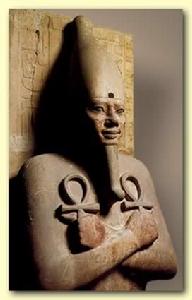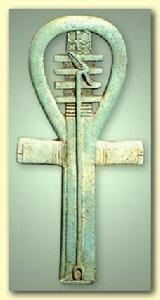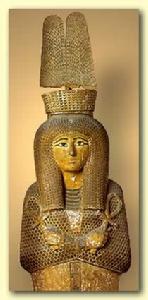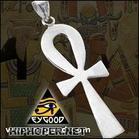概述
 生命之符
生命之符對古埃及學者來說,其形象有何含意仍是個謎。一些專家認為它是子宮形像,但此猜測未被普遍接受。AlanGardiner推測它是便鞋扣帶的形像,其圈讓腳踝套入,因為便鞋扣帶的寫法也是ʿnḫ(但可能讀音不同)。
生命之符是埃及象形文字(又稱聖書體)的字母,解作生命。部份古埃及的神只手持生命之符的圈,或兩手各執生命之符,交叉雙手放於胸前。拉丁文稱此符作ANKH,「有柄的十字」之意。
存在及表現
 生命之符
生命之符生命之符在古埃及的墓地和藝術中常常出現。在畫像中,賦與木乃伊生命的神祇的手指通常繪有生命之符。古埃及人以生命之符作為護身符,有時會加上另外兩個分別代表「力量」和「健康」的字母。鏡子也通常製作成生命之符的形狀。
符號代表
類似的符號 (♀) 代表古羅馬女神維納斯。此符號被稱作「維納斯手持的鏡」。在占星學中,相同的符號代表,它代表金星;在鍊金術中,它代表元素銅;在生物學中,它代表雌性。
在Unicode中,生命之符的編碼是U 2625 (☥)。 生命之符在流行文化中,生命之符被廣泛套用,代表悠久的歷史、神秘的力量,也是古埃及的象徵符號。
英文介紹
 生命之符
生命之符The Ankh was, for the ancient Egyptians, the symbol (the actual hieroglyphic sign) of life but it is an enduring icon that remains with us even today as a Christian cross. It is one of the most potent symbols represented in Egyptian art, often forming a part of decorative motifs.
The ankh seems at least to be an evolved form of, or associated with the Egyptian glyph for magical protection, sa. However, what the sign itself represents is often disputed. For example, Sir Alan Gardiner thought that it showed a sandal strap with the loop at the top forming the strap, but if so, the symbolism is obscure and so his theory has found little real favor early on. However, this interpretation seems to have received some acceptance among modern writers. It would seem that the ancient Egyptians called that part of the sandal 'nkh (exact pronunciation unknown). Because this word was composed of the same consonants as the word "life", the sign to represent that particular part of the sandal, was also used to write the word "life".
Another theory holds that the ankh was symbolic of the sunrise, with the loop representing the Sun rising above the horizon, which is represented by the crossbar. The vertical section below the crossbar would then be the path of the sun
 生命之符
生命之符Wolfhart Westendorf felt it was associated with the tyet emblem, or the "knot of Isis". He thought both were ties for ceremonial girdles. Winfried Barta connected the ankh with the royal cartouche in which the king's name was written, while others have even identified it as a penis sheath. The presence of a design resembling a pubic triangle on one ankh of the New kingdom seems to allow for the idea that the sign may be a specifically sexual symbol. In fact, guides in Egypt today like to tell tourists that the circle at the top represents the female sexual organ, while the stump at the bottom the male organ and the crossed line, the children of the union. However, while this interpretation may have a long tradition, there is no scholarly research that would suggest such an exact meaning.
The ankh, on some temple walls in Upper Egypt, could also symbolize water in rituals of purification. Here, the king would stand between two gods, one of whom was usually Thoth, as they poured over him a stream of libations represented by ankhs.
The ancient gods of Egypt are often depicted as carrying ankh signs. We find Anqet, Ptah, Satet, Sobek, Tefnut, Osiris, Ra, Isis, Hathor, Anibus and many other gods often holding the ankh sign, along with a scepter, and in various tomb and temple reliefs, placing it in front of the king's face to symbolize the breath of eternal life. During the Amarna period, the ankh sign was depicted being offered to Akhenaten and Nefertiti by the hands at the end of the rays descending from the sun disk, Aten. Therefore, the ankh sign is not only a symbol of worldly life, but of life in the netherworld. Therefore, we also find the dead being referred to as ankhu, and a term for a sarcophagus was neb-ankh, meaning possessor of life.
 生命之符
生命之符ItisatleastinterestingthattheankhwordwasusedformirrorsfromatleasttheMiddleKingdomonward,andthatindeed,manymirrorswereshapedintheformofanankhsign.Lifeanddeathmirroreachother,andinanynumberofancientreligions,mirrorswereusedforpurposesofdivination.
Infact,theankhsigninancientEgyptseemstohavetranscendedilliteracy,beingcomprehensibletoeventhosewhocouldnotread.Hence,weevenfinditasacraftsman'smarkonpotteryvessels.
AstheChristianeraeclipsedEgypt'spharaonicpaganreligion,thesignwasadaptedbytheCopticchurchastheiruniqueformofacross,knownasthecruxansata.
古埃及
| 地理 | 埃及 - 上埃及 - 下埃及 - 努比亞 - 尼羅河 - 尼羅河三角洲 -撒哈拉沙漠 - 蘇伊士灣 - 亞喀巴灣 -西奈半島 - 西奈山 - 凱薩琳山 - 帝王谷 - 王后谷 |
| 城市 | 亞歷山大港 - 吉薩 -孟斐斯 - 底比斯 - 阿布拉瓦須 - 阿布西爾 - 塞加拉 - 代赫舒爾 - 利斯特 - 美杜姆 - 哈瓦拉 - 拉罕 - 塞易斯 - 康翁波 - 菲萊島 - 布巴斯提斯 - 赫里奧波里斯 |
| 文化 | 古埃及學 - 法老 - 古埃及語言 - 聖書體 - 世俗體 - 祭祀體 - 古埃及文學 - 古埃及藝術 - 卡諾卜壇 - 生命之符 - 亡靈書- 巫沙布提俑 -古埃及的首飾 - 荷魯斯 - 古埃及的14件神秘瑰寶 |
| 建築 | 古埃及建築- 埃及金字塔 - 方尖碑 - 埃及神廟 - 獅身人面像 - 亞歷山卓燈塔 - 亞歷山大圖書館 - 帝王谷陵墓群 -王后谷陵墓群 - 阿布辛拜勒神廟 - 卡納克神廟 - 羅塞塔石碑 -胡夫葬船 -曼農巨像 |
| 科技 | 古埃及數學 - 古埃及幾何學 - 古埃及醫學 - 古埃及曆法 - 埃及金字塔 - 木乃伊 - 草紙 |
| 宗教 | 古埃及神話 - 九柱主神 |
| 歷史 | 古埃及王朝 - 古埃及歷史 |
| 列表 | 古埃及歷史年表 - 古埃及法老 - 古埃及神話 |

